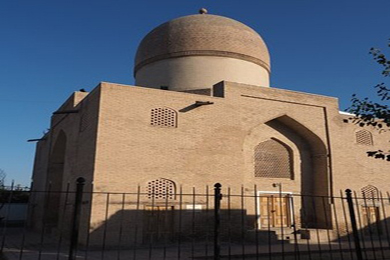Mausoleum of AksarayThe lack of historical data does construction a little mysterious. Assume that the mausoleum could serve as a family tomb for descendants Timurids in the male line. It was erected in the 70th of the 15th century when burials filled Gur-Emir and rooms, adjacent to it. Externally the Joint stock company Shed seems unattractive - is deprived of a decor, the dome remained unfinished. Some incompleteness is felt.
However, from the point of view of architectural construction, it is unique - new technical designs and receptions were used here. Internal furniture does not correspond to an external look wall, sails and a dome are covered by the ornamental painting executed in the kundal equipment with plentiful use of gold. Relief. Gold, extensive scale of color tonality in coloring of magnificent vegetable patterns remind rich carpet fabrics.
History
Any historical data on exact date of construction of the mausoleum Aksaray and its mission are absent. The outstanding Soviet archeologist and the historian-orientalist M.E. Masson assumed that construction of the mausoleum was caused by murder of the governor of Transoxiana Abd is scarlet Latif who on the known circumstances could not be buried in the mausoleum Gur-Emir. At the same time, architectural features of the mausoleum and its internal furniture pull together Aksaray with Ishratkhon's mausoleum that allows to carry it to the 70th years of the 15th century. Assume that the mausoleum could serve as a family tomb for male descendants of family of the sultan Abu-Sayeeda.
By the 20th century, the monument reached in strongly destroyed state. In 1924 — 1925 works on preservation of a structure were carried out that saved the mausoleum from final destruction. Before the beginning of the 21st century it stayed in ruins. In 2007 the mausoleum Aksaray was restored on private money and now is open for tourists.
Architecture
The mausoleum Aksaray represents the one-dome rectangular building in the plan which includes the cross-shaped main hall and three rooms of entrance group. The main hall is blocked by a dome on a high cylindrical drum which is based on the crossed arches and thyroid sails. Narrow, arranged in the form of a ladder dromos conducts in the octagonal crypt revetted with marble with not identified burials. Any external decor at the building is absent that sharply contrasts with its rich internal furniture. In an interior in the basis of walls the panel with a kashinny mosaic. Walls, sails and a dome are covered with the ornamental painting executed in the equipment kundal with plentiful use of gilding.




